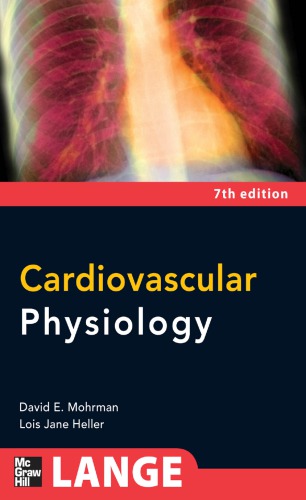

Most ebook files are in PDF format, so you can easily read them using various software such as Foxit Reader or directly on the Google Chrome browser.
Some ebook files are released by publishers in other formats such as .awz, .mobi, .epub, .fb2, etc. You may need to install specific software to read these formats on mobile/PC, such as Calibre.
Please read the tutorial at this link. https://ebooknice.com/page/post?id=faq
We offer FREE conversion to the popular formats you request; however, this may take some time. Therefore, right after payment, please email us, and we will try to provide the service as quickly as possible.
For some exceptional file formats or broken links (if any), please refrain from opening any disputes. Instead, email us first, and we will try to assist within a maximum of 6 hours.
EbookNice Team

Status:
Available4.3
21 reviews
ISBN 10: 0071766529
ISBN 13: 9780071701204
Author: David E Mohrman, Lois Jane Heller
Chapter 1: Overview of the Cardiovascular System
Objectives
Homeostatic Role of the Cardiovascular System
The Basic Physics of Blood Flow
The Heart
The Vasculature
Blood
Foundation for Subsequent Chapters
Key Concepts
Study Questions
Chapter 2: Characteristics of Cardiac Muscle Cells
Objectives
Electrical Activity of Cardiac Muscle Cells
Mechanical Activity of the Heart
Relating Cardiac Muscle Cell Mechanics to Ventricular Function
Key Concepts
Study Questions
Chapter 3: The Heart Pump
Objectives
Cardiac Cycle
Determinants of Cardiac Output
Influences on Stroke Volume
Summary of Determinants of Cardiac Output
Cardiac Energetics
Key Concepts
Study Questions
Chapter 4: Measurements of Cardiac Function
Objectives
Measurement of Cardiac Output
Cardiac Contractility Estimates
Measurement of Cardiac Excitation—The Electrocardiogram
Cardiac Dipoles and Electrocardiographic Records
Mean Electrical Axis and Axis Deviations
The Standard 12-Lead Electrocardiogram
Key Concepts
Study Questions
Chapter 5: Cardiac Abnormalities
Objectives
Electrical Abnormalities and Arrhythmias
Valvular Abnormalities
Key Concepts
Study Questions
Chapter 6: The Peripheral Vascular System
Objectives
Cardiovascular Transport
Basic Vascular Function
Measurement of Arterial Pressure
Determinants of Arterial Pressure
Key Concepts
Study Questions
Chapter 7: Vascular Control
Objectives
Vascular Smooth Muscle
Control of Arteriolar Tone
Control of Venous Tone
Summary of Primary Vascular Control Mechanisms
Vascular Control of Coronary Blood Flow
Vascular Control in Specific Organs
Key Concepts
Study Questions
Chapter 8: Central Venous Pressure: An Indicator of Circulatory Hemodynamics
Objectives
Interaction of System Components
Central Venous Pressure: An Indicator of Circulatory Status
Influence of Central Venous Pressure on Venous Return
Influence of Peripheral Venous Pressure on Venous Return
Determination of Cardiac Output and Venous Return by Central Venous Pressure
Clinical Implications of Abnormal Central Venous Pressures
Key Concepts
Study Questions
Chapter 9: Regulation of Arterial Pressure
Objectives
Short-Term Regulation of Arterial Pressure
Long-Term Regulation of Arterial Pressure
Key Concepts
Study Questions
Chapter 10: Cardiovascular Responses to Physiological Stresses
Objectives
Effect of Respiratory Activity
Effect of Gravity
Effect of Exercise
Normal Cardiovascular Adaptations
Effect of Gender
Key Concepts
Study Questions
Chapter 11: Cardiovascular Function in Pathological Situations
Objectives
Circulatory Shock
Cardiac Disturbances
Hypertension
klabunde cardiovascular physiology
exercise 33 human cardiovascular physiology
levick's introduction to cardiovascular physiology
ninja nerd cardiovascular physiology
klabunde cardiovascular physiology pdf
Tags: David E Mohrman, Lois Jane Heller, Cardiovascular Physiology